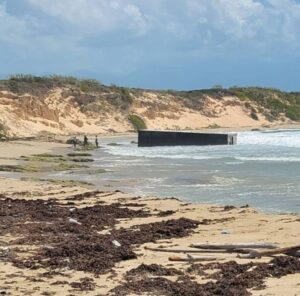
BMR looks to expand in Jamaica
Malvern , St Elizabeth — Just over a year since formal commissioning of its wind farm at Potsdam, Malvern, high in the Santa Cruz mountains, the leadership of BMR Jamaica says the company will not rest on its laurels.
President of BMR Jamaica, Bruce Levy, told Prime Minister Andrew Holness and other visitors recently that the company is now eyeing expansion of renewable energy generation in Jamaica, not just in wind but also solar.
“This is not the only (renewable energy) plant we expect to have in Jamaica, (and) we expect to expand this one,” Levy declared during a welcoming ceremony at the headquarters of the wind farm in Potsdam.
“We are also looking at other places to build renewable plants …” he added.
Levy later told journalists that BMR was assessing the possibility of three additional wind turbines on “empty (leased) lands” at Potsdam and solar plants elsewhere in Jamaica.
He spoke of “opportunities to do solar in several places in Jamaica … we need flat land (for solar). wherever there is flat land, the sun is strong — all over Jamaica — so we think there are opportunities for solar plants there,” he said.
Acquired last year by renowned entrepreneur Richard Branson’s Virgin Group, the wind farm at Potsdam — down the road from Munro College — boasts 11 state-of-the-art wind turbines, each producing 3.3 megawatts of power, for a total of 36 megawatts.
The BMR project, which cost over US$89 million to develop, fits into a drive by successive governments to reduce the country’s oil bill through renewable energy generation. According to the 2016 Economic & Social Survey Jamaica, “The share of energy generated from renewable energy sources increased to 10.5 per cent of total generation from eight per cent in 2015”. The survey document identified BMR, Wigton Windfarm in Rose Hill, Manchester, and a solar photovoltaic power plant in Content Village, Clarendon, as major contributors to renewable energy generation.
Among renewable projects to come is a 37-MW solar photovoltaic plant in Westmoreland, set for completion in late 2018.
While the value of Jamaica’s oil imports has fallen dramatically in recent years in line with plummeting prices globally, it [oil imports] remained a major burden at $968.4 million in 2016. That was down from approximately US$1.106 billion in 2015 and US$1.844 billion in 2014.
Holness told his audience at Potsdam that he believed it was possible to supply up to 50 per cent of energy needs through alternatives to fossil fuels. He pointed to “great potential in this (southern) side of the island, Manchester and St Elizabeth, for an expansion of wind-generation plants”.
He noted that the price of renewable energy to consumers, said to be about 10 to 12 US cents per kilowatt hour, was very competitive compared to fossil-based fuel sources.
The government was doing a resource plan which will project future needs and “how we can supply those future needs integrating renewables, in particular wind and energy …” Holness said.
The prime minister said that while “intermittency of supply” presented a difficulty for renewable energy, rapidly improving technologies including battery technology was changing the situation for the better.
Holness hailed BMR’s policy of integrating the community by allowing local farmers to operate in and around the wind plant.
Levy told journalists that while there had been some initial problems with some farmers wanting to use fire as part of land preparation, such issues had been resolved.
“We have talked to them (farmers) about it, we have set some boundaries — so that their goats for instance don’t come too close to the turbines,” said Levy.
He praised the National Land Agency, which owns the lands at Potsdam, for being “very involved to make sure” BMR’s “partnership” with the community works well.
— Garfield Myers



























